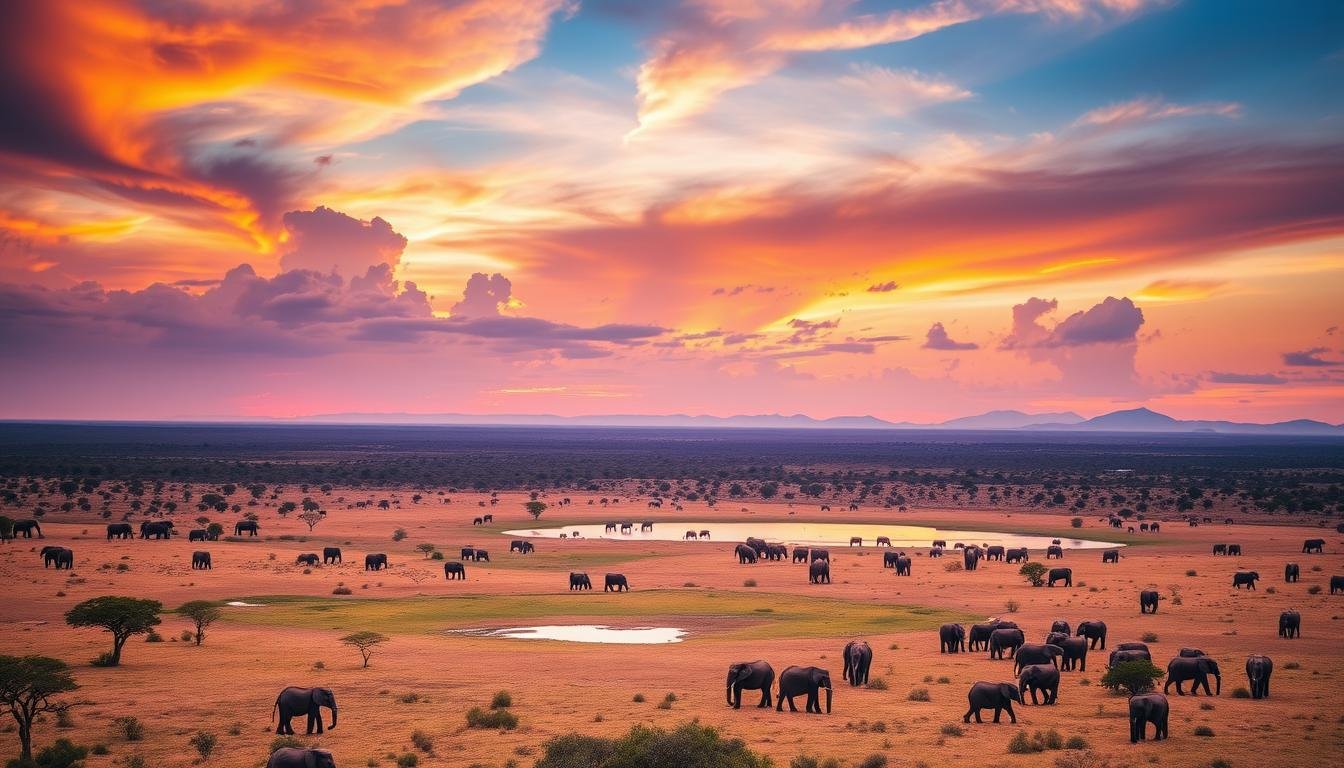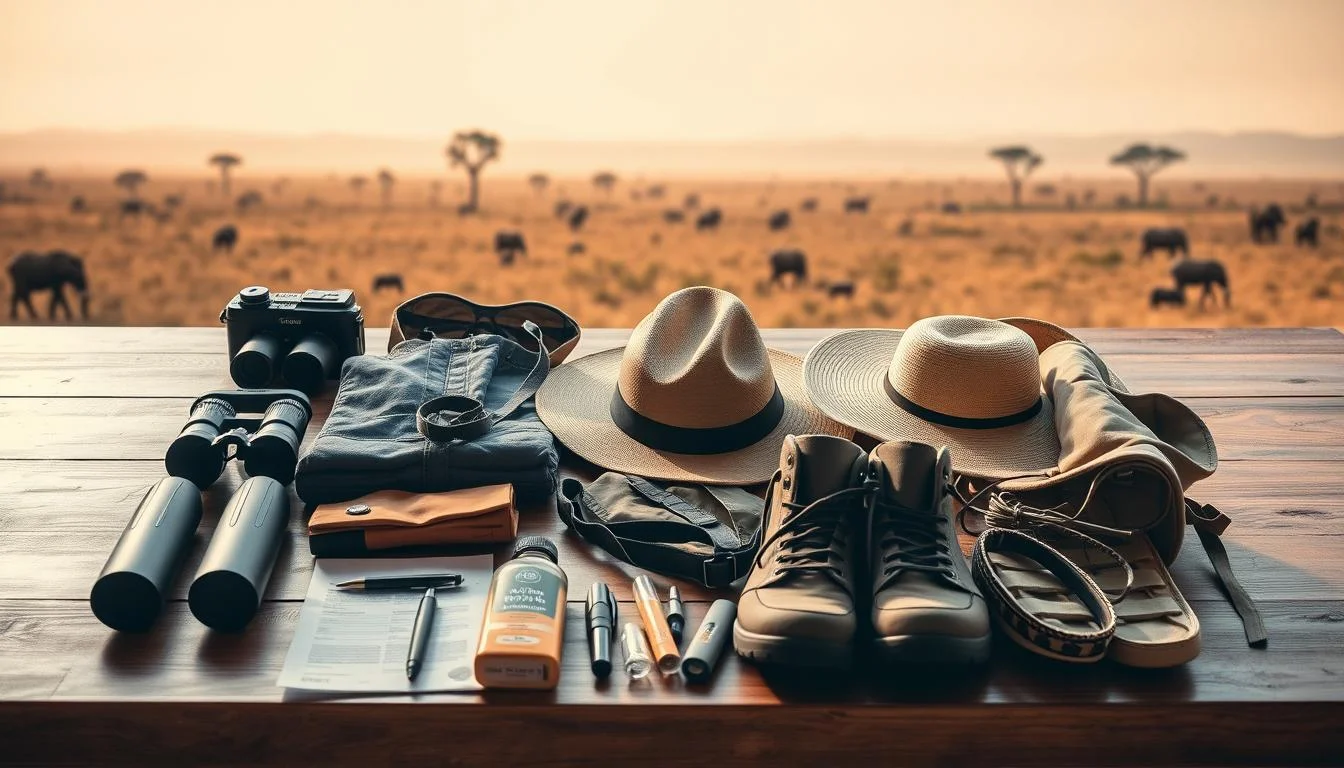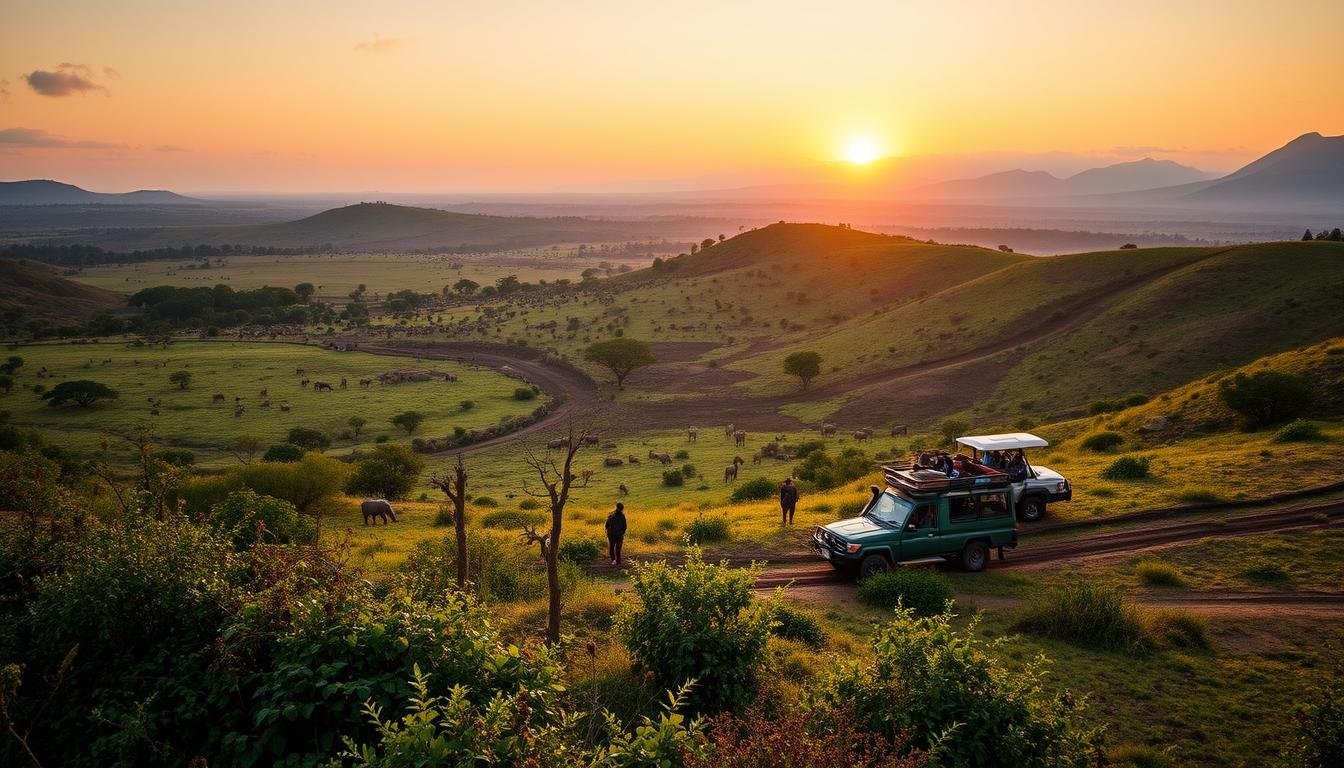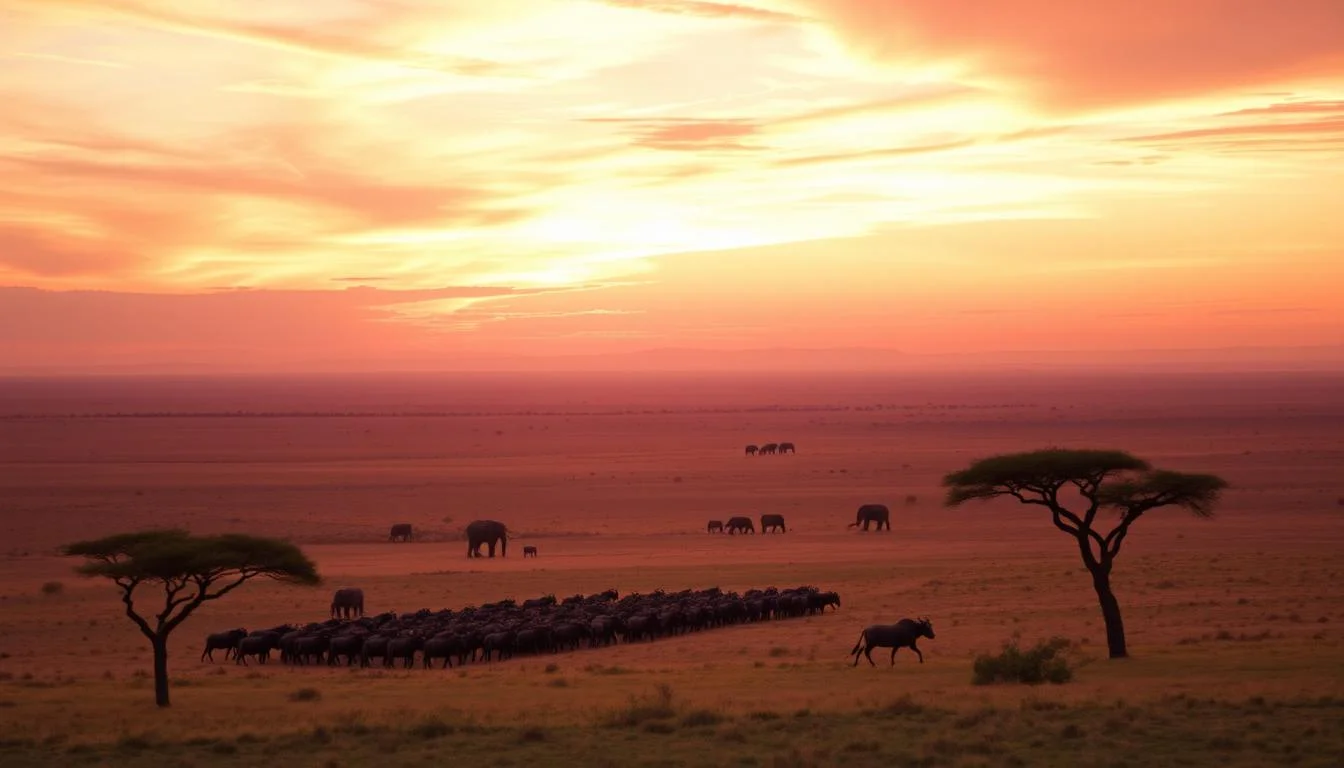Tanzania, nestled in the heart of East Africa, entices travellers from all over the world with the promise of thrilling1 safari adventures. Tanzania is a treasure mine of natural delights waiting to be discovered, from the famed Serengeti savannahs to the pristine solitude of Ruaha National Park and the ethereal beauty of Zanzibar’s beaches. This article will explore the amazing beauty and excitement of safari excursions in Tanzania1.
Key Takeaways
- Tanzania offers a diverse range of safari destinations, from the iconic Serengeti National Park to the remote Ruaha National Park.
- The northern and southern circuits of Tanzania provide unique wildlife viewing experiences, with the northern circuit being more popular and the southern circuit offering a more wilderness-focused adventure.
- Luxury safari accommodations in Tanzania range from world-class lodges to tented camps, catering to various budgets and preferences.
- The Great Wildebeest Migration in the Serengeti is a natural spectacle that draws visitors from around the world.
- Tanzania’s safari destinations are renowned for their abundant wildlife, including the Big Five (lions, leopards, rhinos, elephants, and buffaloes).
Tanzania: Africa’s Wildlife Paradise
Tanzania is renowned as a true wildlife paradise, offering travellers the opportunity to witness a vast array of species in their natural habitats. The allure of Tanzania’s wilderness lies in its diverse ecosystems, from the iconic Serengeti plains to the rugged landscapes of Ruaha National Park. Visitors can explore stunning vistas, ranging from the sweeping savannahs to the lush forests and towering mountains, all while encountering a wealth of tanzania wildlife.
The Allure of Tanzania’s Wilderness
Tanzania’s national parks and tanzania nature reserves are home to an extraordinary tanzania biodiversity2. Serengeti National Park covers approximately 30,000 square kilometers in land area and is home to a wide array of wildlife including Lions, Cheetah, Elephant, Rhino, African Buffalo, Wildebeest, Giraffe, and Zebra2. The annual Wildebeest migration involves large herds of over a million wildebeest and other animals migrating northwards into the Masai Mara National Reserve in Kenya2, with the Great Migration typically occurring between July and the end of August.
Exploring the Stunning Landscapes
Beyond the thriving tanzania wildlife, Tanzania’s tanzania conservation areas offer a diverse array of landscapes for visitors to discover. From the sweeping savannahs of the Serengeti to the towering peaks of Mount Kilimanjaro, the country’s natural wonders are truly breathtaking3. The six-day Kilimanjaro climb starts in Arusha or Moshi via the Machame Route with overnight stays in mountain tents, while the three-day Mount Meru mountain climb starts in Arusha or Moshi with overnight stays in national park huts3. Adventurous travellers can also experience the thrill of a3 Hot Air Balloon safari in Serengeti, offering an hour-long flight over the African savannah at dawn.
“Tanzania is a land of unparalleled natural beauty, where the tanzania wildlife and stunning landscapes converge to create a truly unforgettable safari experience.”
The Serengeti: Where the Great Migration Unfolds
Amongst the vast expanse of Tanzania’s renowned Serengeti National Park lies a spectacle that captivates wildlife enthusiasts from around the world – the Great Migration4. This annual phenomenon involves the movement of over two million ungulates, including wildebeests, zebras, and gazelles, in a circular route across the Serengeti-Mara ecosystem45. The sight of these majestic herds, sometimes stretching for up to 40 kilometres, is truly a testament to the grandeur of nature4.
Witnessing Nature’s Grandest Spectacle
The timing of the Great Migration varies slightly each year due to rainfall patterns, but visitors can typically witness the spectacle unfold during specific seasons5. From June to October, the herds concentrate around the Mara River, where dramatic river crossings often occur, captivating onlookers with the sheer determination and resilience of the animals5. In the October-November period, the wildebeests return to the short-grass plains and calving grounds around Ndutu before starting the Great Migration all over again4.
Abundant Wildlife Year-Round
While the Great Migration is undoubtedly the Serengeti’s prime drawcard, the park boasts an abundance of wildlife year-round6. Lion, leopard, cheetah, elephant, and a myriad of other species can be spotted throughout the diverse habitats, making the Serengeti a true wildlife haven6. The Serengeti Central Safari offers a year-round game-viewing experience, allowing visitors to immerse themselves in the natural wonders of this captivating landscape6.
“The annual migration of two million ungulates through Serengeti National Park is the greatest wildlife spectacle in Africa and perhaps the world.”4
Ngorongoro Conservation Area: A Crater of Diversity
Nestled in the heart of Tanzania’s magnificent wilderness lies the Ngorongoro Conservation Area, a UNESCO World Heritage Site that captivates visitors with its sheer natural splendour. This vast expanse, covering an area of7 809,440 hectares, is a mosaic of highland plains, savanna woodlands, and the iconic Ngorongoro Crater, often referred to as the “eighth wonder of the world”.
The Eighth Wonder of the World
The Ngorongoro Crater, a collapsed volcanic caldera, is the world’s7 largest caldera, offering a unique and thriving ecosystem for a diverse array of wildlife. Established in 1959 as a multiple land use area, the Ngorongoro Conservation Area allows wildlife to coexist harmoniously with the semi-nomadic Maasai pastoralists who call this region home78.
A Natural Amphitheatre of Life
As visitors descend into the Ngorongoro Crater, they are greeted by a lush, green landscape teeming with life. This natural amphitheatre is home to a high density of wildlife, including7 globally threatened species such as the elusive black rhinoceros. The area supports8 over 25,000 large animals and an estimated8 500 bird species, making it a true haven for nature enthusiasts and wildlife photographers.
The annual migration of wildebeest, zebra, gazelles, and other animals is a sight to behold, with8 over 1 million wildebeest, 72,000 zebras, and around 350,000 Thompson and Grant gazelles making their way through the conservation area8. Visitors are advised to time their visit during the dry months of June to September and December to February, when animal sightings are at their peak7.
| Attraction | Key Facts |
|---|---|
| Ngorongoro Crater | |
| Ngorongoro Conservation Area |
|
“The Ngorongoro Crater is a natural wonder that truly takes your breath away. Its sheer size and the diversity of wildlife within it make it a must-visit destination for any safari enthusiast.”
The Ngorongoro Conservation Area’s rich history, dating back to the late 1800s when it was discovered by Austrian explorer Oscar Baumann, has earned it a reputation as a premier safari destination7. With a range of tour packages and accommodation options catering to various budgets and preferences, the Ngorongoro Crater and its surrounding landscapes offer an unforgettable safari experience that showcases the true essence of Tanzania’s wildlife and natural beauty.
safari in tanzania: Ruaha National Park’s Unspoiled Wilderness
For those seeking a more remote and off-the-beaten-path safari experience, Ruaha National Park in southern Tanzania offers an unspoiled wilderness with an intimate encounter with nature9. This expansive park is one of the largest national parks in Africa, known for its rugged beauty and abundant wildlife10.
Off the Beaten Path Safari Experience
With fewer crowds than some of Tanzania’s more popular parks, Ruaha National Park provides a sense of exclusivity and the feeling of having the wilderness all to oneself10. Boasting over 520 different species of birds, the park appeals to birdwatchers seeking a unique safari adventure10.
Rare and Elusive Species
Visitors to Ruaha can spot a diverse array of wildlife, including African wild dogs, large herds of elephants10, leopards, and rare antelope species like the sable and roan9. The park is home to approximately 10% of the world’s lion population9 and one of four cheetah populations in East Africa9. With the third largest wild dog population in the world9, Ruaha National Park offers a truly unique safari experience.
“Ruaha National Park is Tanzania’s largest national park, making it a true hidden gem for safari enthusiasts.”
Safaris in Ruaha are considered to be some of the best in the country9, with wildlife sightings peaking between May and October when the vegetation thins out and animals gather near water sources10. The ‘green season’ from April to November also offers lush vegetation and excellent birdwatching opportunities10.

For those seeking a remote and unspoiled safari experience, Ruaha National Park in Tanzania is a true gem, promising an intimate encounter with nature and the chance to spot some of Africa’s most elusive and rare species10.
Zanzibar: A Tropical Island Paradise
Nestled off the coast of Tanzania, the enchanting island of Zanzibar is a true tropical oasis11. Known as the Spice Island, this semi-autonomous state boasts a rich cultural heritage, stunning white-sand beaches, and crystal-clear turquoise waters that beckon visitors from around the world11.
Pristine Beaches and Rich Culture
Zanzibar’s vibrant culture is a tapestry of diverse influences, from Swahili to Islamic, woven together through centuries of trade and exploration11. The historic Stone Town, a UNESCO World Heritage site, is a captivating maze of narrow streets, intricate architecture, and bustling marketplaces that transport visitors back in time11. Beyond the town, the island’s pristine beaches and azure waters offer a serene sanctuary for those seeking to unwind and soak up the sun11.
From the luxurious resorts of Kendwa and Kiwengwa to the more secluded corners of the island, Zanzibar caters to a diverse range of travellers12. Whether you’re seeking an all-inclusive getaway, a boutique retreat, or a private island experience, this tropical paradise has something to suit every preference13.
Beyond its stunning beaches, Zanzibar is renowned for its vibrant spice trade, with visitors flocking to the island to explore the local production of cinnamon, cloves, and other fragrant spices11. From exhilarating water sports like kitesurfing to cultural immersions in Stone Town, Zanzibar offers a wealth of activities to captivate and delight travellers12.
“Zanzibar is a true gem in the Indian Ocean, offering a unique blend of natural beauty, cultural richness, and a sense of tranquility that sets it apart as a must-visit destination.”
As the perfect complement to a thrilling Tanzanian safari adventure, Zanzibar provides a tropical oasis where visitors can bask in the glory of the region’s diverse natural wonders and immerse themselves in the island’s captivating history and vibrant culture111213.
Planning Your Safari Adventure
When preparing for a Tanzania safari, the right safari operator and a well-thought-out packing list are essential for an unforgettable experience. Choosing the appropriate safari operator can make all the difference, as they possess the local expertise and logistical know-how to ensure a seamless journey14. Additionally, packing the essential items can enhance your comfort and enable you to make the most of your safari adventure.
Choosing the Right Safari Operator
With the vast array of safari operators offering services in Tanzania, it can be daunting to select the right one. According to industry data, a staggering 99% of travellers opt for a tour operator when planning a safari in Tanzania15. This underscores the importance of conducting thorough research to find an operator that aligns with your preferences and budget.
Packing Essentials for Your Safari
Packing the right gear can significantly contribute to the overall enjoyment and comfort of your safari adventure. The recommended minimum duration for a Tanzania safari is 3 days, with two full days of activities and the third day ending in the late afternoon or early evening15. To ensure you are well-prepared, consider including the following items in your safari packing list:
- Passport
- Cash (both local currency and US dollars)
- Lightweight, neutral-coloured clothing
- Sun protection (wide-brimmed hat, sunglasses, and sunscreen)
- Insect repellent
- Camera with spare batteries and a long lens
- Binoculars
- Medical kit
- Power bank
Additionally, it’s essential to familiarise yourself with common Swahili greetings, such as “Jambo,” “Asante,” “Pole,” and “Hakuna Matata,” which can help you engage with the local community during your safari14.
By carefully selecting your safari operator and packing the right essentials, you can ensure a seamless and memorable Tanzania safari experience1415.

Customizing Your Tanzanian Safari
Tanzania’s safari experiences cater to a diverse range of travellers, offering both luxury and budget-friendly options16. Whether you’re seeking a high-end adventure or a more affordable excursion, the country provides a wealth of customisable itineraries to suit your preferences.
Luxury or Budget-Friendly Options
For those seeking an indulgent safari, Tanzania boasts a variety of private and luxurious accommodations, from treehouses to colonial-style lodges and mobile camps16. These upscale options offer unparalleled comfort, service, and proximity to the country’s stunning wildlife and landscapes.
On the other hand, Tanzania also caters to budget-conscious travellers with more affordable safari packages16. These options still provide opportunities to witness the country’s remarkable biodiversity and natural wonders, allowing visitors to immerse themselves in the African wilderness without breaking the bank.
Tailored Itineraries for Families and Groups
For families and groups, Tanzania offers tailored safari experiences that cater to the diverse needs and interests of all participants16. From family-friendly activities to customised group packages, the country ensures an unforgettable journey for travellers of all ages and backgrounds.
| Safari Type | Highlights | Recommended Destinations |
|---|---|---|
| Tanzania Family Safari |
|
|
| Tanzania Group Safari |
|
|
Whether you’re looking for a16 tanzania luxury safari, a16 tanzania budget safari, a16 tanzania family safari, or a16 tanzania group safari, Tanzania’s diverse safari offerings ensure an unforgettable and customised experience for all.
“Tanzania offers some of the best safari experiences in the world, from stunning landscapes to diverse wildlife. With the ability to tailor your adventure, it’s the perfect destination for travellers seeking a truly unique and personalised safari.”
Responsible Tourism in Tanzania
Tanzania, renowned for its breathtaking natural wonders, has made a concerted effort to promote responsible and sustainable tourism practices that protect the environment and empower local communities. Travellers seeking an authentic and meaningful experience can engage in eco-friendly initiatives and support community-based conservation efforts, ensuring the benefits of tourism are equitably distributed.
Eco-Friendly Practices
Tanzania’s tourism industry is leading the way in adopting sustainable solutions. 75% of accommodation options in the country are powered by solar panels, reducing the reliance on fossil fuels and minimising the carbon footprint17. Moreover, the Manyara Tree Planting Project has established 48 acres of new forest near Arusha National Park, contributing to the preservation of the country’s natural habitats17.
Supporting Local Communities
Responsible tourism in Tanzania also focuses on empowering local communities. The Hakuna Matata Academy trains around 200 street kids per year, offering them a future in the tourism industry and a steady income to support their families17. Travellers can further contribute by choosing safari operators that prioritise the wellbeing of local communities, such as African Scenic Safaris, which has been operating in Tanzania for over 14 years and is committed to minimising its carbon footprint18.
By engaging in responsible tourism, visitors can make a tangible difference in Tanzania. From eco-friendly practices to community-based initiatives, travellers can play a vital role in preserving the country’s natural wonders and supporting the livelihoods of its people191718.

“Responsible tourism is not just a trend, it’s a necessity. When we travel, we have the power to make a positive impact on the communities and environments we visit.” – Asha Mweru, Founder of Sustainable Travel Africa
Conclusion
Tanzania’s spectacular safari excursions transport visitors deep into Africa’s heart, where the wild roams free and nature’s treasures abound. From the exciting drama of the Serengeti to the biological richness of the Ngorongoro Conservation Area and the lonely solitude of Ruaha National, Tanzania provides a safari experience that is nothing short of exceptional20.
By discovering the country’s wild and fascinating landscapes, travellers can immerse themselves in the tenacity of the species that call this continent home, with over 1,100 bird species21 and the presence of the iconic Big Five21. The journey can conclude with the idyllic balance of leisure and adventure on the beaches of Zanzibar, a tropical island paradise.
Tanzania’s commitment to conservation efforts21, including anti-poaching programmes and sustainable tourism practices, ensures that visitors can experience the country’s natural wonders responsibly22. Whether it’s witnessing the dramatic Great Migration2021, scaling the heights of Mount Kilimanjaro20, or exploring the UNESCO-listed Olduvai Gorge20, Tanzania’s safari adventures offer an unparalleled opportunity to immerse oneself in the magic of Africa.
FAQ
What are the top safari destinations in Tanzania?
When is the best time to go on a safari in Tanzania?
What kind of wildlife can I expect to see on a Tanzanian safari?
Can I combine a safari with a beach vacation in Tanzania?
How can I ensure I have an eco-friendly and sustainable safari experience in Tanzania?
What should I pack for a safari in Tanzania?
Can I customise my safari itinerary in Tanzania?
Source Links
- https://kenyaluxurysafari.co.uk/tanzania-safaris/tanzania-safari-tour/
- https://www.serengetinationalpark.travel/
- https://paradiessafaris.com/en/
- https://www.serengeti.com/great-migration-africa.php
- https://www.tentwithaview.com/experiences/serengeti-migration-tours.html
- https://www.africanmeccasafaris.com/travel-guide/tanzania/parks-reserves/serengeti/wildebeest-migration
- https://www.ngorongorocratertanzania.org/
- https://whc.unesco.org/en/list/39/
- https://www.tanzaniaodyssey.com/tanzania/ruaha
- https://explorersafari.com/destination/tanzania/ruaha-national-park/
- https://giltedge.travel/zanzibar-tropical-island-paradise/
- https://tanzania-specialist.com/islands/zanzibar-island/
- https://safari.co.uk/destinations/africa/tanzania/zanzibar/
- https://www.izabelphilippa.com/post/tanzania-safari-the-ultimate-safari-guide-do-s-don-ts-planning-tips-itinerary
- https://worldawayfromhome.com/how-to-plan-a-safari-in-tanzania/
- https://www.africanmeccasafaris.com/travel-guide/tanzania/trip-ideas/safari/custom-private
- https://tanzania-specialist.com/responsible-tourism-tanzania/
- https://africanscenicsafaris.com/responsible-tourism
- https://www.responsibletravel.com/holidays/tanzania/travel-guide/responsible-tourism-issues
- https://www.kandooadventures.com/blog/10-reasons-why-tanzania-is-the-best-safari-destination-1129.html
- https://medium.com/@offthebeatenpathsafaris177/wildlife-safari-tanzania-a-journey-into-the-heart-of-the-wild-77d3f0c7992e
- https://africanscenicsafaris.com/blog/how-does-your-safari-in-tanzania-make-a-difference/

